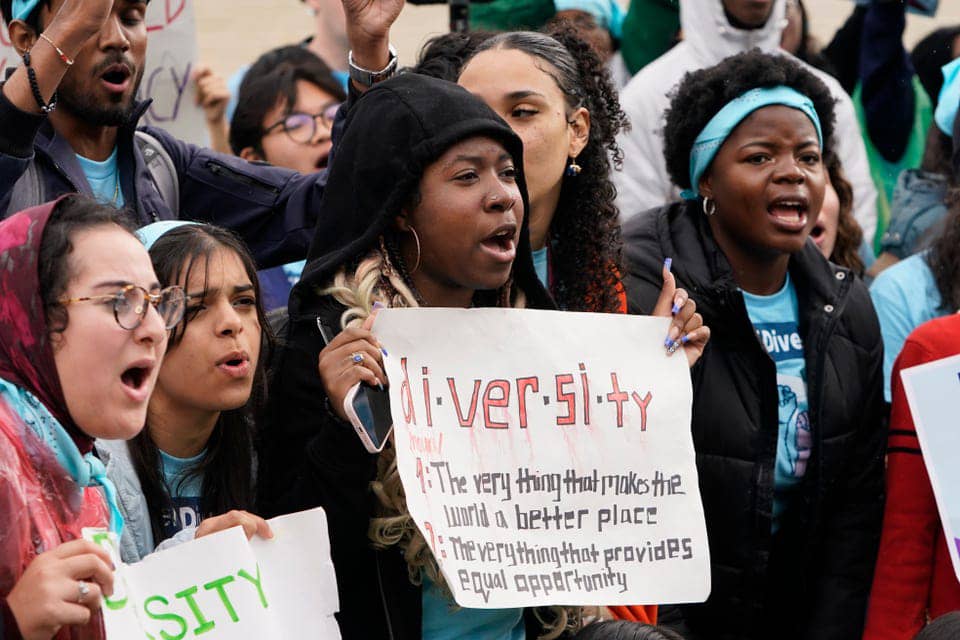Explore the impact of the Supreme Court’s ruling on affirmative action, the reactions from supporters and critics, and the potential challenges universities may face. Discover what lies ahead for the anti-affirmative action movement and the importance of fostering diversity in higher education.

The recent decision by the Supreme Court to declare affirmative action admissions policies used by Harvard College and the University of North Carolina unconstitutional has sparked a significant debate among supporters and critics. The ruling, which deemed the universities’ race-conscious admissions practices as a violation of the equal protection clause of the Constitution’s 14th Amendment, carries profound implications for the diversity of university student bodies and American workplaces.
Supporters And Critics Take To The Streets
Following the Supreme Court’s announcement, both supporters and critics of affirmative action gathered at the court to voice their opinions. Anti-affirmative action groups celebrated the ruling, considering it a step towards a race-neutral society. On the other hand, pro-affirmative action activists expressed concerns about the decision further diminishing diversity in higher education.
Impact On University Administrators
Harvard University President-elect Claudine Gay acknowledged the need to adapt their approach to pursuing the educational benefits of diversity in light of the Supreme Court’s decision. While Harvard will comply with the ruling, Gay emphasized that their values remain unchanged, and they believe in the importance of a diverse intellectual community for academic excellence and the development of future leaders.
However, some supporters of affirmative action worry that university leaders may face limitations in their efforts to foster a diverse student body. Aram Sinnreich, a professor at American University, stressed the importance of institutional support for social justice, rather than leaving the burden solely on students. He expressed concerns about the ruling’s potential impact on his own classroom and whether the university’s actions would be enough to compensate for the loss caused by the Supreme Court’s decision.
Christopher Banks, the director of education and workforce development at the Urban League of Portland, referred to the Supreme Court’s decision as a “disaster.” He emphasized the importance of not setting limitations on the younger generation, as they are key to maintaining the United States’ power status.

The Future Of The Anti-Affirmative Action Movement
The Supreme Court’s ruling is the result of years of litigation against affirmative action policies, spearheaded by Edward Blum, the president of Students for Fair Admissions. Blum emphasized the legal and moral obligation of colleges and universities to adhere strictly to the Supreme Court’s opinions. His organization will closely monitor any potential use of proxies for race in admissions processes.
Yukong Mike Zhao, the founding president of the Asian American Coalition for Education, hailed the ruling as a “historic victory” for Asian communities, ensuring equal protections under the law. Zhao also highlighted the need for education system reforms to address the root causes of the lack of diversity in higher education, particularly focusing on improving K-12 education for Black and Hispanic children.
Voices From The Student Community
Harvard College student Hana O’Looney expressed her support for affirmative action during a rally near the Supreme Court. She emphasized the benefits of diversity in classrooms, schools, and the country as a whole. O’Looney, who is Asian American, criticized the notion that affirmative action discriminates against Asian Americans and denounced the use of racial identity to promote white supremacy.
Sarah Zhang, a student at the University of North Carolina at Chapel Hill and the founder of the Affirmative Action Coalition, expressed frustration over the ruling. Zhang had dedicated months to advocating for affirmative action and considered the decision a setback for student groups that support it.
Jeannie Park, director of the Coalition for a Diverse Harvard, emphasized the setback caused by the Supreme Court’s decision in efforts to increase diversity and racial equity in higher education. The Coalition for a Diverse Harvard, an advocacy group supporting race-conscious admissions policies, believes that affirmative action has been a valuable tool for decades. Park argued that there was no justification for overturning the use of race as one of many factors in the holistic admissions process.
Moving Forward: Emphasizing Campus Diversity
In light of the Supreme Court’s decision, colleges and universities now face an even greater responsibility to double down on their efforts to promote and enhance campus diversity, particularly in support of students of color. It is imperative to create an inclusive environment that fosters the growth and success of individuals from diverse backgrounds.
Promoting A Holistic Admissions Process
With the removal of race-conscious admissions policies, universities may need to reevaluate their selection criteria and adopt a more holistic approach to evaluating applicants. By considering a wide range of factors beyond academic achievements, such as extracurricular activities, personal experiences, and socioeconomic background, institutions can still strive to create diverse student bodies without explicitly considering race.
Investing In Outreach And Support Programmes
To ensure equal opportunities for all students, universities must invest in outreach programs targeting underrepresented communities. By actively engaging with and providing resources to students from diverse backgrounds, educational institutions can bridge the gap in access to quality education and empower students to pursue higher education.
Additionally, implementing support programs that address the specific challenges faced by marginalized students can contribute to their academic success and retention rates. Mentoring initiatives, tutoring services, and affinity groups can create a sense of belonging and support networks for students from underrepresented backgrounds.
Enhancing K-12 Education
To address the root causes of the lack of diversity in higher education, it is crucial to focus on improving K-12 education for all students, especially those from disadvantaged communities. By investing in quality education from an early age, providing equitable resources, and addressing systemic inequalities, colleges and universities can pave the way for a more diverse and inclusive future.
Collaboration And Advocacy
In the face of the Supreme Court’s ruling, collaboration and advocacy become essential tools for change. Students, faculty, and community members can join forces to advocate for policies that promote diversity, equality, and inclusivity in higher education. Engaging in dialogue, organizing peaceful protests, and raising awareness about the importance of diverse perspectives can help shape public opinion and influence future decisions.
The Supreme Court’s decision on affirmative action has sent ripples through the education system, impacting universities, students, and communities across the nation. While the ruling has created challenges, it has also ignited a renewed determination to foster diversity, equity, and inclusion in higher education. By adopting alternative strategies, investing in outreach and support programs, and prioritizing comprehensive evaluation criteria, universities can continue their commitment to creating an intellectually vibrant and diverse academic environment that prepares students for a globalized world.
Ultimately, the path forward requires collective effort and a dedication to promoting equal opportunities for all, regardless of race or background. By embracing the principles of diversity and inclusivity, educational institutions can shape a future where every student has the opportunity to thrive and contribute to society.





